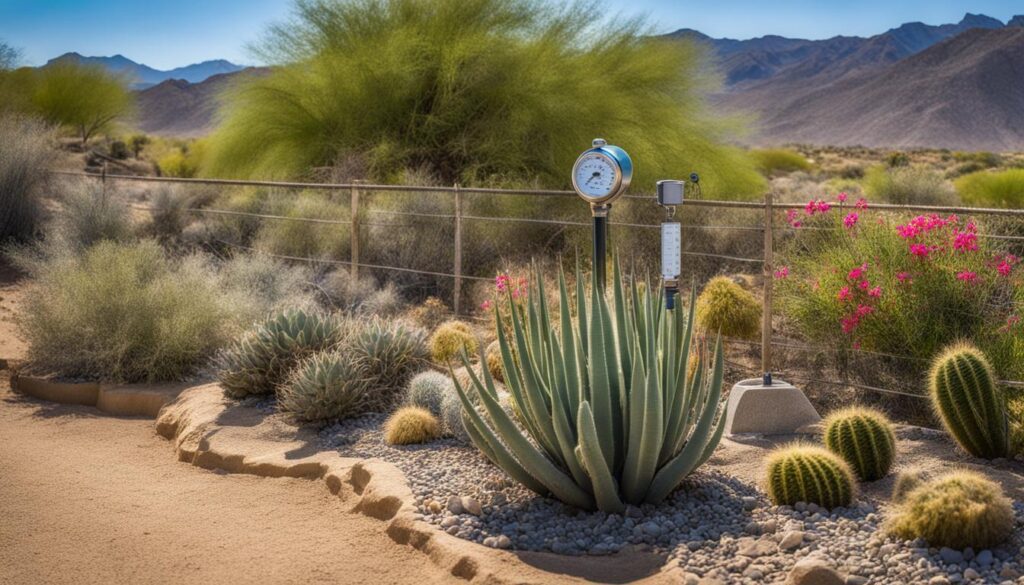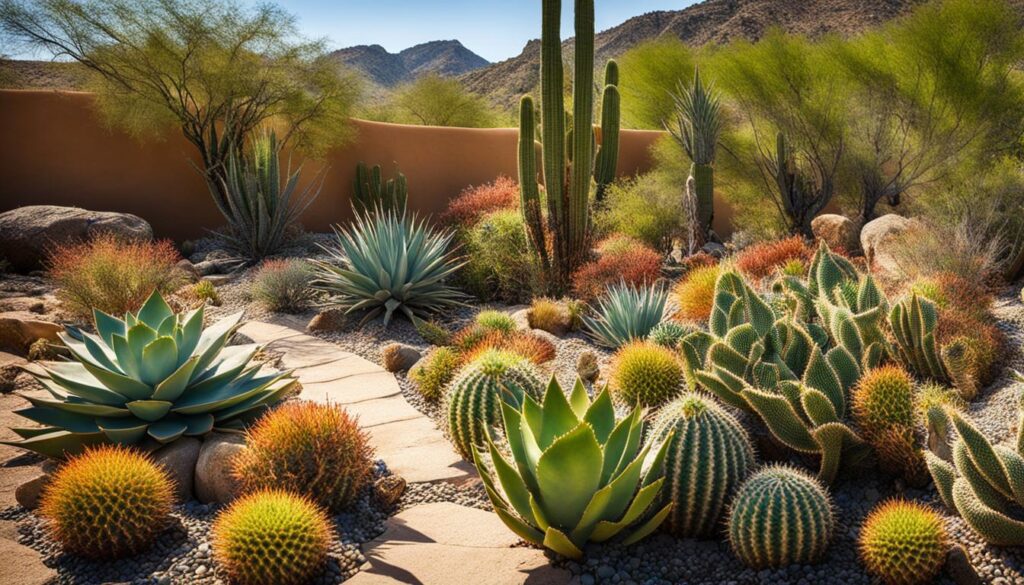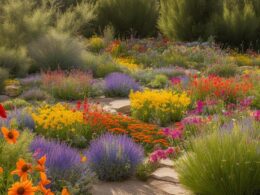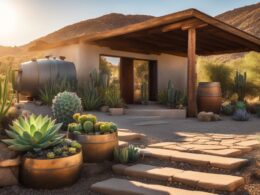Are you tired of skyrocketing water bills and looking for practical solutions to conserve water? Look no further than xeriscape design. With its focus on creating water-efficient gardens, xeriscaping offers a sustainable approach to landscaping that not only reduces water usage but also enhances the beauty of your outdoor space.
By implementing xeriscaping techniques, you can significantly lower your water bills while contributing to water conservation efforts. This article will guide you through the principles and benefits of xeriscape design, providing practical tips for creating a water-efficient landscape that thrives even in arid climates.
Key Takeaways:
- Xeriscape design is a sustainable landscaping practice that helps conserve water
- Implementing xeriscaping techniques can significantly reduce water bills
- Xeriscaping focuses on creating water-efficient gardens
- By following the principles of xeriscaping, you can create visually appealing landscapes while minimizing water usage
- Xeriscaping promotes environmental sustainability, cost savings, and increased property value
What is Xeriscaping?
Xeriscaping is a landscaping practice that focuses on designing and maintaining landscapes with minimal water requirements. It is a sustainable approach that aims to reduce or eliminate the need for supplemental irrigation, making it an ideal choice for homeowners looking to conserve water and reduce their water bills.
At its core, xeriscaping is about selecting plants and utilizing techniques that thrive in arid or drought-prone environments. By choosing drought-tolerant plants and implementing water-saving strategies, such as efficient irrigation systems and proper soil preparation, xeriscaping minimizes water usage while still creating visually appealing and sustainable landscapes.
The key principle of xeriscaping is to work with the natural water cycle and the climate of the region. By understanding the water requirements of different plant species and grouping them according to their needs, homeowners can create harmonious and water-efficient gardens. Xeriscaping is not just about aesthetics; it is a holistic approach that considers the ecological and environmental impact of landscaping practices.
The Benefits of Xeriscaping
Xeriscaping offers a wide range of benefits that make it an attractive landscaping choice for homeowners. One of the primary advantages is water conservation. By implementing xeriscape design techniques, you can significantly reduce outdoor water usage compared to traditional landscapes. In fact, xeriscaping can reduce water consumption by up to 75%. This is especially important in areas facing water scarcity or prone to drought. By conserving water, you are not only saving money on your water bills but also contributing to the overall sustainability of our environment.
In addition to water conservation, xeriscaping promotes environmental sustainability. Traditional landscaping often relies on chemical fertilizers and pesticides, which can have harmful effects on the ecosystem. With xeriscaping, you minimize the use of these chemicals, creating a healthier and more balanced environment for both plants and wildlife. By choosing native plants that are adapted to the local climate, you also support biodiversity and help preserve the natural habitat.
Another significant benefit of xeriscaping is the potential for cost savings. By reducing your water consumption, you can enjoy lower water bills. Additionally, xeriscaped landscapes require less maintenance, saving you time and money on lawn care. Moreover, xeriscaping can increase the market value of your property. Homebuyers are increasingly interested in sustainable and water-efficient homes, so a well-designed xeriscape can be a valuable selling point.
Summary:
- Xeriscaping reduces outdoor water usage by up to 75% compared to traditional landscapes, contributing to water conservation efforts.
- It promotes environmental sustainability by minimizing the use of chemical fertilizers and pesticides.
- By reducing water consumption, xeriscaping can lead to cost savings on water bills and lower maintenance expenses.
- A well-designed xeriscape can increase the market value of your property.
With its water-saving benefits, environmental sustainability, cost savings, and increased property value, xeriscaping is a smart choice for homeowners looking to create beautiful, low-maintenance landscapes while making a positive impact.
Practical Tips for Xeriscaping
Implementing xeriscaping techniques requires careful planning and attention to various aspects of your landscape. By following these practical tips, you can create a water-efficient and visually appealing garden.
1. Soil Preparation:
Before starting your xeriscaping project, it’s essential to prepare the soil properly. Ensure proper drainage by amending the soil with organic matter, such as compost, and incorporating it to a depth of at least six inches. This will help retain moisture and promote healthy root growth.
2. Plant Selection:
Choose plants that are well-suited to your local climate and soil conditions. Opt for drought-tolerant species that require minimal water once established. Native plants are a great choice as they are adapted to the local environment and often have lower water requirements. Group plants with similar water needs together to make irrigation more efficient.
3. Efficient Irrigation:
Consider using water-efficient irrigation methods, such as drip irrigation or soaker hoses, to deliver water directly to the plant’s root zone. This reduces water loss due to evaporation and ensures that the right amount of water reaches the plants. Set timers on irrigation systems to avoid over-watering and adjust watering schedules based on weather conditions.
4. Hardscaping and Mulching:
Incorporate hardscaping elements, such as gravel pathways or decorative rocks, to reduce the area that requires watering. These features not only add visual interest but also help conserve water. Mulching is another effective technique that helps retain soil moisture, suppresses weeds, and regulates soil temperature. Use organic mulch, such as wood chips or straw, around plants to improve water efficiency.
5. Maintenance and Monitoring:
Regular maintenance is crucial for the long-term success of your xeriscaped garden. Remove weeds promptly, as they compete with your plants for water and nutrients. Monitor soil moisture levels to ensure plants are receiving adequate water without over-irrigating. Keep an eye out for pests or diseases and take appropriate measures to prevent or treat them.
By following these practical tips, you can create a beautiful and water-efficient xeriscaped garden that not only saves you money on water bills but also contributes to a more sustainable future.
Drought-Tolerant Plants
In xeriscaping, choosing the right plants is essential for creating a water-efficient and visually appealing landscape. Drought-tolerant plants, also known as xeriscape-friendly plants or xerophytes, are an ideal choice for xeriscaped gardens. These plants are naturally adapted to arid climates and require minimal water, making them perfect for reducing water usage in your garden.
Examples of drought-tolerant plants include cacti, succulents, native plants, and herbs. Cacti and succulents, with their thick fleshy leaves and stems, are excellent at retaining moisture and can survive long periods of drought. Native plants, which are indigenous to your region, are well-suited to local environmental conditions and require less water and maintenance. Herbs such as lavender, rosemary, and sage not only add beauty to your garden but also have low water requirements.
Benefits of Drought-Resistant Plants
- Drought-resistant plants require less water, reducing your water bills and conserving water resources.
- They are low-maintenance, saving you time and effort in gardening tasks.
- Drought-resistant plants are often more resistant to pests and diseases, reducing the need for chemical pesticides.
- They promote biodiversity by attracting beneficial insects and wildlife to your garden.
- Drought-tolerant plants are visually appealing, adding texture, color, and interest to your landscape.
By incorporating drought-tolerant plants into your xeriscaped garden, you can create a sustainable and water-efficient landscape that thrives even in dry climates or during periods of water scarcity. These plants not only reduce water consumption but also offer numerous environmental and aesthetic benefits to your outdoor space.
How Can Xeriscape Design Help Reduce Water Bills for Residential Properties?
Xeriscape design is one of the most effective residential water conservation techniques. By utilizing drought-tolerant plants and efficient irrigation systems, xeriscaping can significantly reduce water usage and help lower water bills for residential properties. This eco-friendly approach to landscaping is a smart investment for homeowners looking to save money while conserving water.
Conclusion
Xeriscape design is an effective solution for reducing water bills and creating sustainable gardens. By implementing practical tips and techniques, you can achieve water-efficient landscapes that not only conserve water but also enhance the beauty and value of your property.
Through careful soil preparation, thoughtful plant selection, and efficient irrigation methods, you can significantly reduce your water usage. Additionally, incorporating hardscaping and mulching techniques can further retain moisture in the soil, reducing the need for supplemental watering.
By embracing xeriscape design, you are taking a step towards sustainable living and responsible water usage. Not only will you contribute to water conservation efforts, but you will also enjoy the benefits of lower water bills and a visually appealing garden. Start implementing these practical tips today and create a beautiful, sustainable landscape that will make both your wallet and the environment happy.












